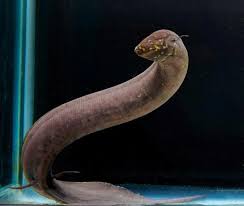South American Lungfish : Study

Recent study revealed that the South American lungfish genome grew massively during the past 100 million years.
- South American lungfish is a freshwater species (Lepidosiren paradoxa).
- It is the nearest living relative to the first land vertebrates and closely resembles its primordial ancestors dating back more than 400 million years.
- It is mainInhabiting slow-moving and stagnant waters in Brazil, Argentina, Peru, Colombia, Venezuela, French Guiana and Paraguay.
- It has the largest genome compared to any of the animals on the earth.
- The length of the DNA in each cell of this lungfish would extend almost 60 metres. The human genome would extend a mere 2 metres.
- Its genome is more than 50 times the human genome’s size.
- The world’s four other lungfish species live in Africa, also with large genomes.
- Its genomes are largely composed of repetitive elements – about 90% of the genome.
Lungfish:
- Lungfish first appeared during the Devonian Period.
- It was during the Devonian that one of the most important events in the history of life on the earth occurred when fish possessing lungs and muscular fins evolved into the first tetrapods.




